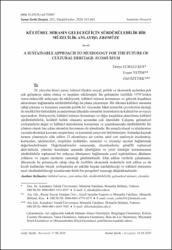| dc.description.abstract | The second half of the 20th century has witnessed many social, political, and economic developments on a global scale and affected people. These developments affected the understanding of museology especially after the 1970s and brought sustainability to the fore in the context of preserving and transferring cultural heritage to the next generations. Maintaining and protecting a country's cultural heritage is essentially a political vision, but with the support of the architectural community, arousing a qualified traditional and cultural awareness will bring the architectural productions to a high level in the country. Therefore, the conservation of cultural heritage and transferring it to other generations is very important in terms of cultural sustainability, collective memory formation. the study deals with the "ecomuseum" concept, which stands out as a sustainable method for the preservation and survival of the natural and cultural heritage of traditional settlements. For this purpose, the ecomuseum concept has been researched in literature and its theoretical framework has been determined. Then, a total of 12 ecomuseums operating in different countries of the world were selected by the survey method. When determining the examples, firstly, ecomuseums, which attract attention with their traditional architectural texture, host a remarkable heritage in this sense and are active today, were preferred. the samples were analyzed with qualitative data analysis and evaluated in the context of founders, operators, exhibition spaces, exhibition objects, and the number of visitors. Besides, the strengths, weaknesses, opportunities, and threats of the ecomuseums, in general, were revealed through SWOT analysis. It has been determined that more than 600 ecomuseums are active around the world today. Although the ecomuseums have the same principles and goals, it has been observed that they differ from each other in the context of their establishment, operation methods, and the heritage resources they exhibit. These differences between ecomuseums should not be perceived as polyphony, but as the richness of different experiences, by this means they can guide new initiatives. However, in some ecomuseums, it is seen that the local people tend to obtain financial benefits before preserving their heritage due to the lack of sufficient knowledge of what the ecomuseum means. This situation is dangerous for the future of the ecomuseums. For this reason, the lack of awareness of the public -both local people and tourists- was considered as the weakest aspect of organizing the ecomuseum. in ecomuseum initiatives, this problem should be resolved immediately. It is essential in terms of eliminating many weaknesses and threats such as damage or harm caused by lack of knowledge, inability to own, unconscious consumption, and adjustment problems. Although the local people do not take an active role in the initial stage in most cases, they get involved in the process and adopt it as the level of their awareness increases. the well-preserved heritage is a powerful resource not only for tourists but also for local communities to appreciate their heritage and for the transmission of traditional practices and intergenerational knowledge. This is a situation adopted by the ecomuseum because the main target group of an ecomuseum is its local people and its main purpose is to support and empower a community to develop and manage its cultural heritage. As a result, an ecomuseum is a flexible tool where local people can manage their cultural heritage, first by preserving their traditions and resources, and then by obtaining financial benefits through attracting everyone to their lands to see, learn and experience. in this context, it is thought that the study will present a different perspective on how settlements that have this potential in our country, especially those that have been abandoned or used limitedly for economic reasons can participate in life and how their cultural heritage can be sustained. | en_US |


















